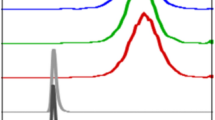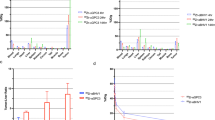Abstract
Hepatocellular carcinoma (HCC) has a very high incidence and mortality. Early diagnosis and timely treatments are therefore required to improve the quality of life and survival rate of HCC patients. Here, we developed a vascular endothelial growth factor (VEGF)-based multimodality imaging agent for single photon emission computed tomography (SPECT), computed tomography (CT) and magnetic resonance imaging (MRI) and used it to assess HCC mice and explore the combinative value of CT/MRI-based morphological imaging and SPECT functional imaging. HCC targeting with 125I-labeled bevacizumab monoclonal antibody (mAb) was examined using SPECT/CT in HepG2 tumor-bearing mice after intravenous mAb injection. Based on this, an integrated, bimodal, VEGF-targeted, ultrasmall superparamagnetic iron oxide (USPIO)-conjugated 99mTc-labeled bevacizumab mAb was synthesized to increase tumor penetration and accumulations. The in vivo pharmacokinetics and HepG2 tumor targeting were explored through in vivo planar imaging and SPECT/CT using a mouse model of HepG2 liver cancer. The specificity of the radiolabeled nanoparticles for HepG2 HCC was verified using in vitro immunohistochemistry and Prussian blue staining. With diethylenetriamine pentaacetic acid as a bifunctional chelating agent, USPIO-bevacizumab achieved a 99mTc labeling efficiency of >90 %. The in vivo imaging results also exhibited the targeting of USPIO on HepG2 HCC. The specificity of these results was confirmed using in vitro immunohistochemistry and Prussian blue staining. Our preliminary findings showed the potential of USPIO as an imaging agent for the SPECT/MRI of HepG2 HCC.






Similar content being viewed by others
References
Siegel AB, Cohen EI, Ocean A, Lehrer D, Goldenberg A, Knox JJ, Chen H, Clark-Garvey S, Weinberg A, Mandeli J, Christos P, Mazumdar M, Popa E, Brown RS Jr, Rafii S, Schwartz JD (2008) Phase II trial evaluating the clinical and biologic effects of bevacizumab in unresectable hepatocellular carcinoma. J Clin Oncol 26:2992–2998
Bruix J, Sherman M, Llovet JM, Beaugrand M, Lencioni R, Burroughs AK, Christensen E, Pagliaro L, Colombo M, Rodés J (2001) Clinical management of hepatocellular carcinoma: conclusions of the Barcelona-2000 EASL conference. European Association for the Study of the Liver. J Hepatol 35:421–430
Bennett GL, Krinsky GA, Abitbol RJ, Kim SY, Theise ND, Teperman LW (2002) Sonographic detection of hepatocellular carcinoma and dysplastic nodules in cirrhosis: correlation of pretransplantation sonography and liver explant pathology in 200 patients. Am J Roentgenol 179:75–80
Snowberger N, Chinnakotla S, Lepe RM, Peattie J, Goldstein R, Klintmalm GB, Davis GL (2007) Alpha fetoprotein, ultrasound, computerized tomography and magnetic resonance imaging for detection of hepatocellular carcinoma in patients with advanced cirrhosis. Aliment Pharmacol Ther 26:1187–1194
Mazzaferro V, Regalia E, Doci R, Andreola S, Pulvirenti A, Bozzetti F, Montalto F, Ammatuna M, Morabito A, Gennari L (1996) Liver transplantation for the treatment of small hepatocellular carcinomas in patients with cirrhosis. N Engl J Med 334:693–699
Fletcher JW, Djulbegovic B, Soares HP, Siegel BA, Lowe VJ, Lyman GH, Coleman RE, Wahl R, Paschold JC, Avril N, Einhorn LH, Suh WW, Samson D, Delbeke D, Gorman M, Shields AF (2008) Recommendations on the Use of 18F-FDG PET in oncology. J Nucl Med 49:480–508
Yamamoto Y, Nishiyama Y, Kameyama R, Okano K, Kashiwagi H, Deguchi A, Kaji M, Ohkawa M (2008) Detection of hepatocellular carcinoma using 11C-choline PET: comparison with 18F-FDG PET. J Nucl Med 49:1245–1248
Park YN, Kim YB, Yang KM, Park C (2000) Increased expression of vascular endothelial growth factor and angiogenesis in the early stage of multistep hepatocarcinogenesis. Arch Pathol Lab Med 124:1061–1065
Ferrara N, Hillan KJ, Novotny W (2005) Bevacizumab (Avastin), a humanized anti-VEGF monoclonal antibody for cancer therapy. Biochem Biophys Res Commun 333:328–335
Zhu AX, Blaszkowsky LS, Ryan DP, Clark JW, Muzikansky A, Horgan K, Sheehan S, Hale KE, Enzinger PC, Bhargava P, Stuart K (2006) Phase II study of gemcitabine and oxaliplatin in combination with bevacizumab in patients with advanced hepatocellular carcinoma. J Clin Oncol 24:1898–1903
Nagengast WB, de Vries EG, Hospers GA, Mulder NH, de Jong JR, Hollema H, Brouwers AH, van Dongen GA, Perk LR, Lub-de Hooge MN (2007) In vivo VEGF imaging with radiolabeled bevacizumab in a human ovarian tumor xenograft. J Nucl Med 48:1313–1319
Laurent S, Forge D, Port M, Roch A, Robic C, Vander Elst L, Muller RN (2008) Magnetic iron oxide nanoparticles: synthesis, stabilization, vectorization, physicochemical characterizations, and biological applications. Chem Rev 108:2064–2110
Qiao RR, Yang CH, Gao MY (2009) Superparamagnetic iron oxide nanoparticles: from preparations to in vivo MRI applications. J Mater Chem 19:6274–6293
Shanehsazzadeh S, Oghabian MA, Lahooti A, Abdollahi M, Abolghasem Haeri S, Amanlou M, Daha FJ, Allen BJ (2013) Estimated background doses of [67Ga]-DTPA-USPIO in normal Balb/c mice as a potential therapeutic agent for liver and spleen cancers. Nucl Med Commun 34:915–925
Shanehsazzadeh S, Oghabian MA, Daha FJ, Amanlou M, Allen BJ (2013) Biodistribution of ultra small superparamagnetic iron oxide nanoparticles in BALB mice. J Radioanal Nucl Chem 295:1517–1523
Li X, Du X, Huo T, Liu X, Zhang S, Yuan F (2009) Specific targeting of breast tumor by octreotideconjugated ultrasmall superparamagnetic iron oxide particles using a clinical 3.0-Tesla magnetic resonance scanner. Acta Radiol 50:583–594
Lee CM, Jeong HJ, Kim EM, Kim DW, Lim ST, Kim HT, Park IK, Jeong YY, Kim JW, Sohn MH (2009) Superparamagnetic iron oxide nanoparticles as a dual imaging probe for targeting hepatocytes in vivo. Magn Reson Med 62:1440–1446
Lijnen HR, Stassen JM, Vanlinthout I, Fukao H, Okada K, Matsuo O, Collen D (1991) Comparative fibrinolytic properties of staphylokinase and streptokinase in animal models of venous thrombosis. Thromb Haemost 66:468–473
Rusckowski M, Qu T, Gupta S, Ley A, Hnatowich DJ (2001) A comparison in monkeys of 99mTc labeled to a peptide by 4 methods. J Nucl Med 42:1870–1877
Schluep T, Hwang J, Hildebrandt IJ, Czernin J, Choi CH, Alabi CA, Mack BC, Davis ME (2009) Pharmacokinetics and tumor dynamics of the nanoparticle IT-101 from PET imaging and tumor histological measurements. Proc Natl Acad Sci USA 106:11394–11399
Hoppin J, Orcutt KD, Hesterman JY, Silva MD, Cheng D, Lackas C, Rusckowski M (2011) Assessing antibody pharmacokinetics in mice with in vivo imaging. J Pharmacol Exp Ther 337:350–358
Frangioni JV (2008) New technologies for human cancer imaging. J Clin Oncol 26:4012–4021
Acknowledgments
This work was supported, in part, by the National Natural Science Foundation of China (NSFC) under Contract No. 81201130 and 81271608 and Young investigator start funding under contract No. Y-2013-11 from Shanghai Institute of Medical Imaging. The authors also acknowledge Drs. Yinjian Zhang and Jianpin Zhang from Fudan University Shanghai Cancer Center helping with small animal SPECT/CT imaging.
Author information
Authors and Affiliations
Corresponding authors
Rights and permissions
About this article
Cite this article
Zhao, Y., Yao, Q., Tan, H. et al. Design and preliminary assessment of 99mTc-labeled ultrasmall superparamagnetic iron oxide-conjugated bevacizumab for single photon emission computed tomography/magnetic resonance imaging of hepatocellular carcinoma. J Radioanal Nucl Chem 299, 1273–1280 (2014). https://doi.org/10.1007/s10967-013-2846-7
Received:
Published:
Issue Date:
DOI: https://doi.org/10.1007/s10967-013-2846-7




